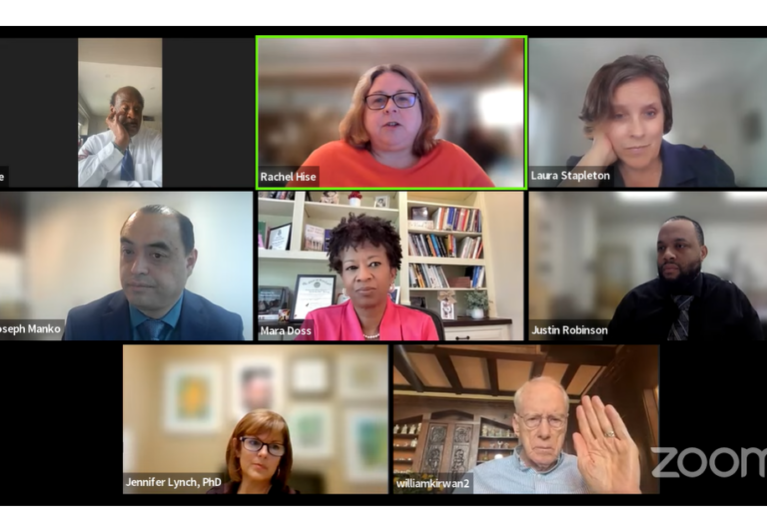As a Republican executive in a dark blue state, Maryland Gov. Larry Hogan has one of the toughest balancing acts in the country. Gov. Hogan must stay true to the small-government principles that propelled him into the office, while governing within the confines of a left-of-center state.
But now the popular Maryland leader faces an unprecedented challenge: the Kirwan Commission, which has proposed an annual $4 billion increase in school spending to revamp the education system in Maryland. Gov. Hogan has rightly lambasted these outrageous proposals, but his efforts to fend off historically high tax increases will be in vain unless moderates and Maryland media give him a fair hearing. The stakes for students, teachers and taxpayers are simply too high to kowtow to the Kirwan Commission’s pie-in-the-sky plan.
When former University System of Maryland Chancellor William “Brit” Kirwan unveiled his commission’s $4 billion proposed price-tag for education reforms, Gov. Hogan wasted little time criticizing the “Kirwan Tax Hike Commission.”
And Hogan has a point, since the plan would likely cost Maryland households an additional $6,000 over the next five years (or $1,200 per year) if these proposals become law. In particular, Baltimore City Public Schools would need to spend an additional $330 million per year post-implementation, despite already spending more than $16,000 per pupil.
This astronomically high sum puts the Baltimore public school system in the top 5 highest funded (per pupil) systems nationwide. With the systemic problems in the Baltimore school system, most Marylanders could be forgiven for thinking otherwise. Somehow, these sums cannot keep the air conditioning running or the students well-supervised.
But maybe this isn’t a question of funding levels, but rather about priorities.
The system has the highest administrative costs in the country and shells out thousands of dollars on dinner cruises for staff and parents, lavishly catered PTA meetings, and ludicrously expensive theater performances. Meanwhile, teachers have had to collect fans for students to keep them coming to class on hot days, lest the lack of air conditioning keeps them at home.
The suggestion by former chancellor Kirwan and others that more money be thrown at the problem has rightly riled Hogan. Baltimore Sun State House reporter Luke Broadwater accuses the governor of “Breaking out his old playbook … reprising his role as an anti-tax agitator on social media.”
According to Broadwater, Hogan is reprising his pre-gubernatorial tactics successfully used to channel public opposition to the “rain tax” on non-porous pavement. These efforts against the rain tax were key to his election, as Marylanders were sick of having to pay some of the highest taxes in the nation. The state already levies a top tax rate of 5.75%, on top of around 5% in county and local taxes.
Since entering office, Gov. Hogan has realized the limits of his low-tax vision. He hasn’t been able to make much of a dent in Maryland’s income tax rates, even if he successfully kiboshed the rain tax.
But taxpayers and pro-taxpayer groups realize that, even if Gov. Hogan can’t turn Maryland into a low-tax state, he can at least use his bully pulpit to fight extra, miscellaneous “fees” cooked up by out-of-touch officials. The electorate is weary of further taxation, even as Maryland voters cite education as a key priority. Gov. Hogan can take the lead on this important issue by pushing for a comprehensive reprioritization of education funding across the state.
First and foremost, the governor and state officials must ensure that, when there’s corruption and frivolous spending, there are consequences. Prince George’s County residents were shocked to learn of a major grade-rigging conspiracy in their school system involving scores of teachers and guidance counselors. Yet, only a handful of those responsible were removed, and there’s little assurance that business as usual will come to an end. An education “broken windows” approach would send a message to schools across Maryland that reckless spending will be met with firings and greater state scrutiny.
Gov. Hogan has a difficult task ahead of him as he pushes back against the Kirwan Commission and tries to control the political narrative on education. But students’ education — and taxpayer dollars — depend on the governor controlling education funding and holding school systems accountable.
— ROSS MARCHAND
The writer is the director of policy for the Taxpayers Protection Alliance.
Did someone forward this to you?
Get your own daily morning news roundup in your inbox. Free. Sign up here.




 Creative Commons Attribution
Creative Commons Attribution